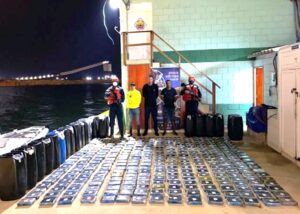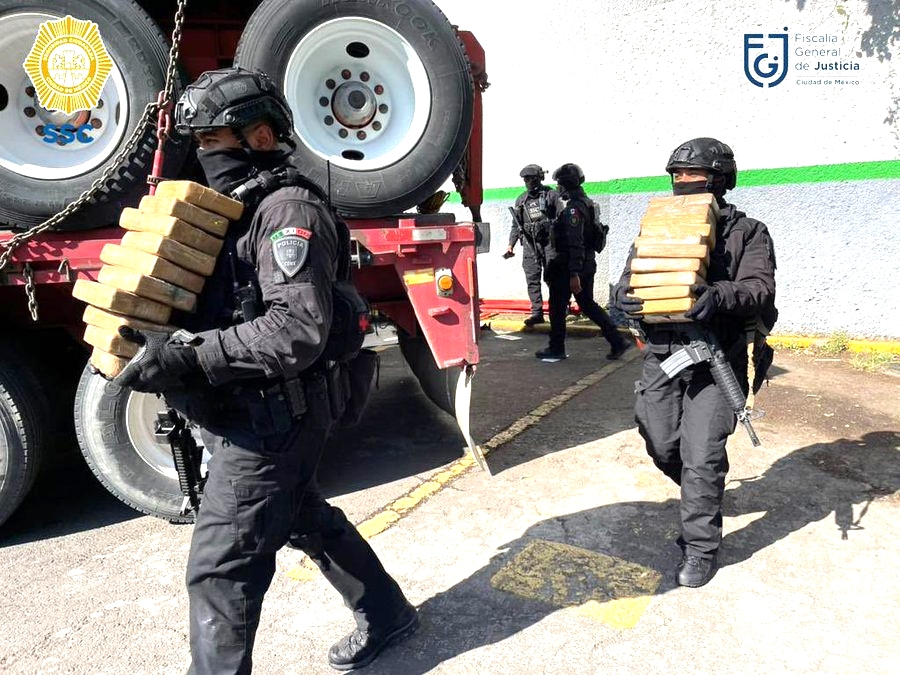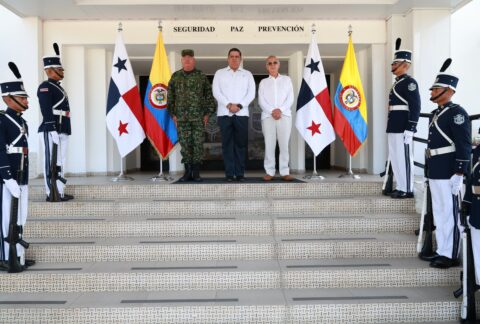In late July 2022, the Secretariat for Citizen Security of Mexico City (SSC), in coordination with the Attorney General’s Office, carried out what it described as the largest cocaine seizure in Mexico City with the interdiction of two trailers containing 1.68 tons of cocaine from Colombia bound for the United States.
The load had come by sea to Puerto Escondido, Oaxaca, continued on to the Mexican capital, where part of it was to be distributed in the Tepito neighborhood, while the rest was meant for the U.S. West Coast, the SSC indicated. For organized crime experts, the seizure exposed a drug superhighway through the Pacific from Colombia via Mexico City, with California as the final destination.
According to Spanish newspaper El País, the U.S. shared intelligence with the SSC, with precise details on the trucks’ route and where the drugs would be stored. The information came from Colombia thanks to a series of intercepted calls between narcotraffickers.
“This shows that these organizations are always looking for the most efficient places in terms of transport time and with less surveillance, and above all […] to reach the consumer markets,” Yadira Gálvez, a security expert and academic at the National Autonomous University of Mexico, told Diálogo on September 8.
The superhighway
Since 2019, InSight Crime, an organization that specializes in organized crime in Latin America and the Caribbean, has been pointing to the Pacific coast of the Americas as the new corridor for narcotrafficking to the United States, in an attempt to avoid the “noise” due to the crisis in Venezuela and its negative effect on neighboring countries in the Caribbean.
Cartel hitmen have been escorting some of the shipments leaving via this maritime highway to ward off pirates, or to distract authorities when they pursue illegal shipments, InSight Crime said.

Mexico’s Sinaloa Cartel currently dominates the cocaine transshipment route through the U.S. Pacific, Mexican magazine Zeta reported in May. Mexican states with Pacific coastlines (such as Michoacán, Colima, Chiapas, Oaxaca, and Guerrero) are attracting a lot of attention for this traffic.
“As a result, the dynamics in the operation of local groups may begin to change. This leads us to think about [countries’] detection capabilities, and corruption in strategic points such as ports. These factors are becoming intertwined,” Gálvez said, adding that “there are more drugs being trafficked […] in the drug dealing markets in our [Latin American] countries, one of the most complex elements of the issue.”
Narcotraffickers most frequently use speedboats, small fishing boats, and narco subs to move tons of cocaine, marijuana, fentanyl, and heroin, newspaper El Sol de México reported. Criminals even use sport boats to conceal their movements and evade surveillance in international waters.
Effort and commitment
Since the implementation of the Bicentennial Framework agreement between the governments of Mexico and the United States (in December 2021), naval authorities have seized more than 10 tons of drugs coming from South America by sea and air. Mexican ports on the Pacific are the points of greatest seizures, Zeta reported.
Colombia, as the country of origin of drug shipments, has also been intensifying the fight against narcotrafficking through various actions, including the Colombian Navy-led Multinational Naval Campaign Orion, with has the participation of some 40 countries in the Americas, Africa, and Europe, the naval institution said in a statement.
According to the Colombian Navy, the effort and commitment of participating countries in the nine versions of the Orion Campaign prevented 716 tons of cocaine and 266 tons of marijuana from being consumed worldwide. The campaign began in 2018.
Since 2016, the Colombian Navy’s International Maritime Center for Analysis Against Narcotrafficking (CIMCON) and the Mexican Department of the Navy (SEMAR) have strengthened military intelligence exchange to detect drug shipments via sea, news platform El Sol de México reported.
Increased cooperation
“Mexico, the United States, and Colombia are consistently addressing the fact that the Pacific route has grown in importance, exchanging intelligence and developing interdiction capabilities,” said Gálvez. However, “a commitment from Central American countries is needed to carry out this information exchange and seizures.”
Although international cooperation plays a strong role, each country has to strengthen its own countertrafficking strategy, Gálvez added. Not only must drugs be prevented from being trafficked, but law enforcement agencies must be strengthened and go beyond the big leaders.
In addition, greater cooperation and integration of U.S. Northern Command (NORTHCOM) and U.S. Southern Command (SOUTHCOM) is needed to work with key countries along narcotrafficking route to interdict narcotics, Gálvez concluded, adding that narcotrafficking “generates a huge trail of corruption in its wake.”









